| China |
| Expats explore Xiamen's traditional Chinese cultural heritage | |
|
|
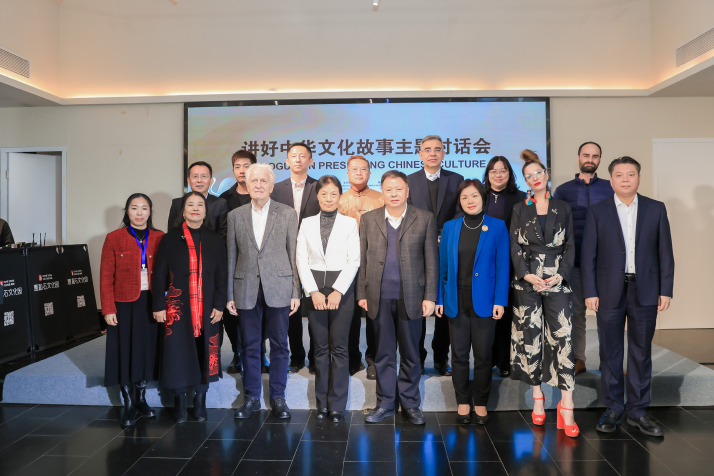 Participants in a seminar entitled Themed Dialogue on Telling China's Culture and Story in Xiamen, Fujian Province, pose for a photo on December 20, 2023 (CICG AMERICAS)
"Early in the morning, I went for a walk along Yundang Lake and came across a group of tai chi (an ancient and distinctive Chinese form of exercise that involves flowing and rhythmic moves) practitioners," Evandro Menezes de Carvalho, a professor of law at and head of the Brazil-China Center at FGV Law School in São Paulo, Brazil, said when asked about his first impression of Xiamen, a coastal city in the southeastern Chinese province of Fujian. Menezes was one of the participants in a four-day event, from December 19 to 22, 2023, that explored Xiamen's cultural inheritance and innovation.
Yundang Lake, located in the heart of Xiamen, is a seawater lake that reflects the urban landscape surrounding it like a shiny mirror. But this wasn't always the case... The lake used to be very dirty, but since the late 1980s, the local government has transformed it into a prime tourist destination and a popular spot for locals to relax and unwind. "The harmony between Xiamen's people and nature is enchanting," Menezes said, adding that one very particular thing about China has always entranced him—the country's culture of subtlety. Something he immediately noticed in Xiamen, too. The event was jointly organized by the China International Communications Group Center for the Americas (CICG Americas) and the Information Office of the Xiamen Municipal People's Government. It was part of a tour delving into Xiamen's cultural heritage, during which participants visited several related institutions and sites such as the Gezai Opera Research Center, Cai's Lacquer Thread Sculpture Gallery and Kulangsu Gallery of Foreign Artifacts From the Palace Museum Collection on Kulangsu (also known as Gulangyu) Island, as well as participated in a seminar entitled Themed Dialogue on Telling China's Culture and Story. 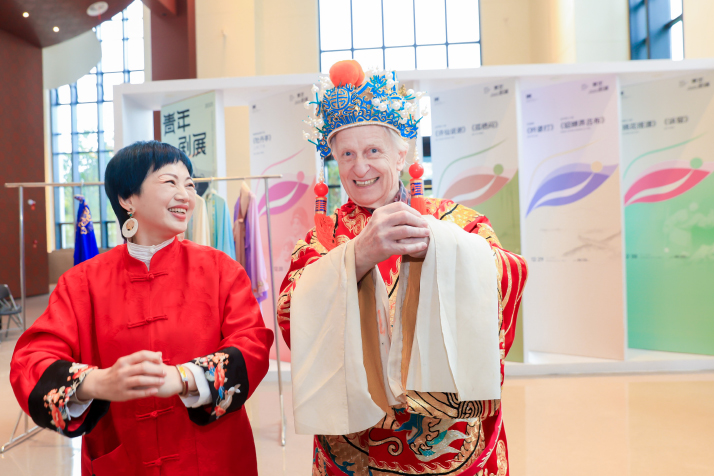 German director and author Uwe Kräuter learns to master some typical Gezai Opera gestures with Zhuang Hairong, deputy head of the Xiamen Gezai Opera Research Center, in Xiamen on December 20, 2023 (CICG AMERICAS)
Touch and try The welcome hall of the Gezai Opera center on December 20 was packed with performers decked out in full costume and makeup. Each of them went on to introduce the character(s) they play on stage and the tunes they sing, as well as the distinctive instruments used in the opera. The folk art that has its roots in Fujian, incorporates elements from Peking Opera, Liyuan Opera, a genre popular in southern Fujian, and Beiguan Opera—which actually has a large fan base in China's Taiwan region. "The dress seems like it was made for me," German director and author Uwe Kräuter, a participant of the event, laughed after trying on the traditional costume. "We learned about the details of the costumes, the meanings behind the makeup, and how the voices of the actors reveal the essence of each character. The deepest meanings of Gezai Opera lie in the details... And this says a lot about China, its culture and its philosophy," Menezes added. He is also chief executive editor of China Hoje, a Portuguese quarterly published by CICG Americas, and has spent years researching China and China-Brazil relations, frequently participating in intercultural academic exchanges. "I wanted to have direct contact with China, its people, cuisine, music, daily life and art," Menezes said when recalling his first arrival to China in 2013 for a three-year stay as a senior scholar at the Shanghai University of Finance and Economics. "Although many Western authors are excellent observers, scholars and interpreters of Chinese society, I wanted to experience China directly, not through books," Menezes added. Cai's Lacquer Thread Sculpture Gallery also pleasantly surprised many of the participating expats. The traditional folk handicraft that uses lacquer threads to create decorative patterns is especially popular in Fujian's Xiamen and Quanzhou cities. First taking shape in the mid-17th century, lacquer thread sculpting was listed as national intangible heritage in 2006. A mixture of brick powder, lacquer tree sap and boiled tung oil, an oil used as a drying agent in inks, paints and varnishes, generates a sticky, elastic dough, which is then rolled into threads. Craftspeople subsequently coil, pile, carve and engrave the threads onto the sculpture. After applying a primer, the sculpture is coated with gold foil to give it a lasting shimmer and shine. Menezes's eye soon spotted a trio of sculptures telling history-defining accounts from the Three Kingdoms Period (220-280). From his perspective, this kind of handicraft "is unique, full of details, and packed with elements that refer to Chinese mythology, history and literature." After learning and trying how to roll threads and coil them onto the sculpture, Jose Noel Halili Antivola, Foreign Investment Director of Yingke Matrix (Xiamen) Investment and Consultancy Co. Ltd., from the Philippines, told Beijing Review that having been in China for more than a decade and having learned a lot about the country's culture, this type of exquisite craftsmanship still amazed him. "I was deeply moved by the sculptures, and all these impressive moments are now embedded in my memory," Kräuter echoed. 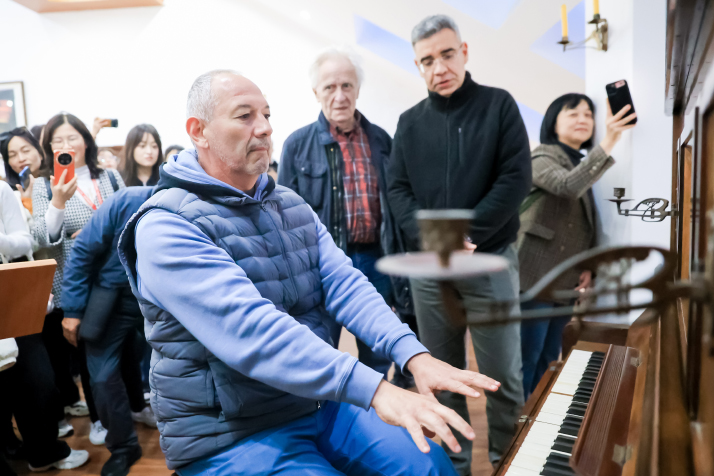 Colombian music blogger Héctor Palacios "plays the piano" at a piano museum on Kulangsu Island in Xiamen on December 20, 2023 (CICG AMERICAS)
Inheritance and innovation Sometimes, an impromptu inquiry can become food for innovative thought. "Can lacquer thread sculpting be used to design earrings?" Elsbeth van Paridon, a Dutch Sinologist and editorial consultant at Beijing Review, asked while pointing to her own ears. Though the reply was negative, she smiled and said, "Well then, this might be an idea for the next phase of crafty innovation." According to Zhang Xueping, head of the gallery, the art of lacquer thread sculpting has already gone through three stages of innovation over the course of its centuries-long development. "Take the latest stage, for instance," he said. "Today, 3D-printing technology has been adopted in the creation of sculptural bodies." Gezai Opera, in the meantime, is turning to contemporary ways of communication to expand its fan base: social media. From short videos on Douyin, the Chinese version of TikTok, to BiliBili, a Chinese YouTube-equivalent mainly targeting Gen Zs, audiences today can enjoy a Gezai Opera performance from their village courtyards to a college campus, Zhuang Hairong, deputy head of the research center, told Beijing Review. "Our opera also draws inspiration from contemporary events in its creation to appeal to new-generation audiences," she added. Colombian music blogger Héctor Palacios has been a resident of Xiamen for more than two decades. He said he'd like to bring this kind of traditional opera to people in his own country and explore, together with its performers, how to "integrate Latin America and China through unique musical beats." "Inheritance" and "innovation" are also key words for the Kulangsu Gallery of Foreign Artifacts From the Palace Museum Collection, the museum's first branch outside of Beijing. The gallery exhibits cultural relics from the 16th to the early 20th centuries, including artifacts from Britain, France, Germany, Italy and the Netherlands. The gallery was converted from a hospital originally built by a Dutch-American missionary in 1898. Besides hosting impressive artifacts, it is also developing its own guochao products. Guochao, literally meaning "national wave," refers to products packed with traditional Chinese cultural elements. When asked about her vision for its future, Lin Yinqiong, head of the gallery, told Beijing Review that she hopes "more and more foreign tourists coming to the island can pay the gallery a visit and realize how artifacts from their countries, as well as the lifestyles behind these items, are well-preserved and promoted here." "I think it's also the responsibility of a museum, like this one, to promote international and cultural exchange," Van Paridon added. 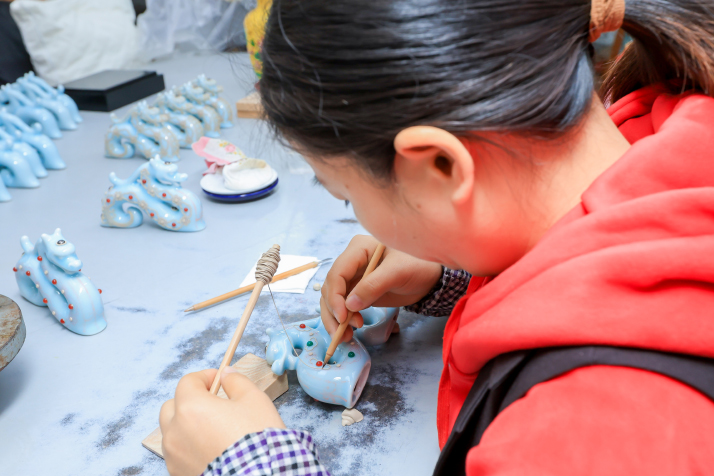 A craftswoman creates a lacquer thread sculpture at Cai's Lacquer Thread Sculpture Gallery in Xiamen on December 21, 2023 (CICG AMERICAS)
Communication and consensus Van Paridon went to Xiamen three times in 2023, giving her "a 360-degree view of the place." In her eyes, the city is equally impressive in each of its facets, whether it's the business side that has been developing since it first opened up as a seaport in the 17th century, or its modern, vibrant and young prowess, or its honoring of tradition which today mixes and matches with the influx of technology and contemporary thinking. "We should all make joint efforts and contribute with our own skills, no matter whether these skills are in art, culture, business, sports, science or any other field, to do something that helps to preserve Xiamen's culture and heritage, and share its beauty with the world," Palacios said. "Regional cultural characteristics such as those that the expats experienced during their four-day stay in Xiamen, are an integral part of the Chinese civilization," Li Yafang, President of CICG Americas, said in her speech at the closing seminar, adding that their interpretation through contemporary viewpoints are significant in presenting Chinese culture to overseas audiences and promoting mutual learning between the Chinese and other civilizations. 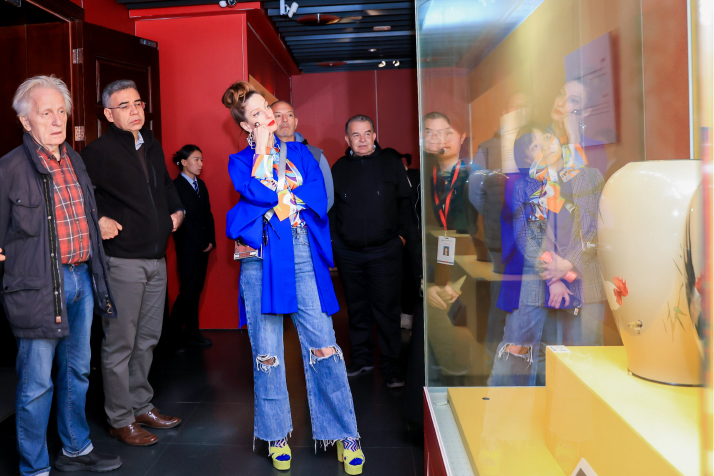 Delegates visit the Kulangsu Gallery of Foreign Artifacts From the Palace Museum Collection in Xiamen on December 20, 2023 (CICG AMERICAS)
According to Kräuter, over the past five decades of his life in China, he has met many outstanding Chinese artists, and the communication with them inspired him to think more about cultural exchange. "Among the cultural interactions between East and West, we should continuously be aware of and respect the historical development of different civilizations," he said. At the seminar, on behalf of all participants, Li released a five-point consensus, calling on different civilizations to work together to promote human progress through exchange, mutual learning and inclusiveness. (Reporting from Xiamen, Fujian Province) (Print Edition: A Tour to Remember) Copyedited by Elsbeth van Paridon Comments to mamm@cicgamericas.com |
|
||||||||||||||||||||||||||||
|
